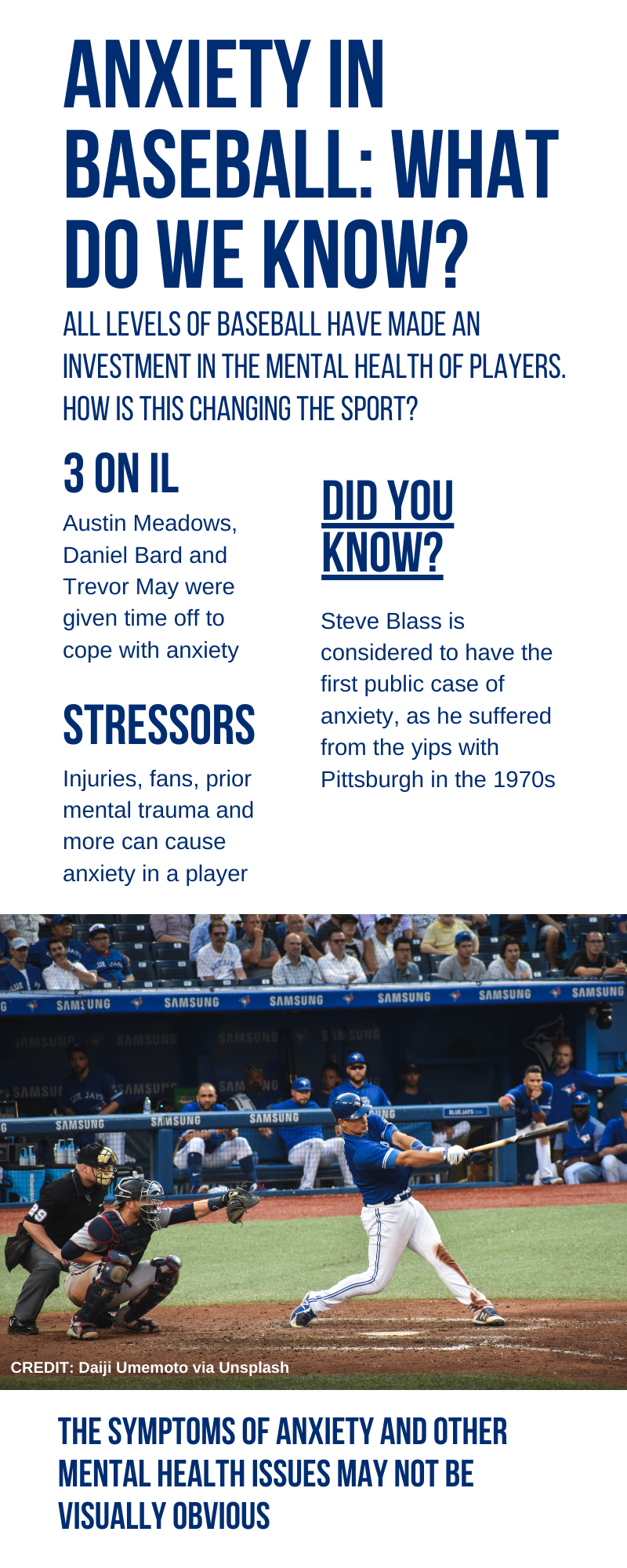Mental Health Awareness and Anxiety in Baseball
How players at different levels of baseball experience issues with mental health

Three Major League Baseball players have been placed on the injured list this season in order to deal with mental health issues, specifically anxiety. They are taking time away from the field, and time away from their team, in order to cope with their anxiety.
While it is not entirely new for a player to take time off to deal with mental health issues, the three players this year ties the 2009 season for the most players to be put on the injured list for anxiety. It is only May, a little more than one month into the 2023 MLB season. Prior to the 1991 season, no players were placed on the injured list, then called the disabled list, to cope with mental health issues, per Bleacher Report.
This raises the question on what has caused the sport to change its views on anxiety and the mental health of its players. According to Tom Ferraro, a sports psychologist and psychoanalyst, the awareness of mental health issues is something that has increased at all levels of the sport, from the sandlot to the Majors.
How does anxiety affect players?
Baseball players can be affected by anxiety in a variety of ways. One of the most common symptoms, according to Ferraro, is the yips. He describes the yips as a type of muscle spasm.
“They lose control of their function,” Ferraro said, “So it’s usually very embarrassing, shameful, traumatic, and not that unusual.”
When a player suffers from this condition, they can struggle to do tasks that might’ve seemed easy for them at one time. One common result of the yips is a fielder struggling to throw to first base. Some notable players to struggle with this issue include former Rookie of the Year winners Steve Sax and Chuck Knoblauch.
Some Los Angeles Dodgers fans with seats down the first base line even wore helmets to protect themselves whenever Sax played second base.

The symptoms of anxiety, however, are not always visible when watching a player perform. Some players, like Ethan Mishra, a redshirt freshman pitcher at Tulane University, go through internal struggles while playing the game.
“There’s a feeling you get in your stomach where you know you can do it,” said Ethan Mishra, a redshirt freshman at Tulane University. “But there’s something that’s holding you back. I’ve actually had that issue this recent season, fall and spring, where I’m struggling with overcoming my anxiety issues, just putting a lot of pressure on myself to perform at a very high level.”
Some players have also cited mental health issues when coming back from an injury. Ferraro works with many athletes who have suffered injuries and are going through the rehabilitation process.
“They’re worried they may get reinjured,” Ferraro said. “So all of the sudden, everything comes with hesitation and you start to get skittish. You don’t play as fluidly as you should and you’re not playing as you used to play.”
Josh Hejka, a pitcher in the New York Mets organization, is actively recovering from Tommy John surgery. It took him several months to come to the decision to get surgery after spending several months trying to rehab his UCL injury without the procedure.
Hejka cited facing a high level of uncertainty around his injury as causing him a lot of anxiety.
“You just feel like every good day was followed by a bad day,” Hejka said, “And every bad day was followed by a good day. It just left me in this limbo.”




Sources of anxiety among players
At every level of baseball, there are players that experience anxiety. Ferraro works with players of all ages, including some at the youth level who are playing with travel teams. After working with a variety of patients, he is very aware of when issues with anxiety begin.
“When it’s then work-oriented as opposed to play-oriented, that’s the beginning of real problems,” Ferraro said.
This sentiment is also echoed by Will Tynes, a redshirt sophomore pitcher at Tulane University.
“It’s a very common issue, especially among college and pro guys,” Tynes said. “Because really it’s the first time that you play not just for fun. Yeah, you still play for fun, but it’s also a job.”

A young child playing baseball. Tynes says that this level of baseball is simply just fun. Starting in college, players begin to feel stress because it becomes a job. CREDIT: Bill Stephan via Unsplash
A young child playing baseball. Tynes says that this level of baseball is simply just fun. Starting in college, players begin to feel stress because it becomes a job. CREDIT: Bill Stephan via Unsplash
Josh Hejka discusses his experiences with uncertainty during his time in professional baseball.
Josh Hejka discusses his experiences with uncertainty during his time in professional baseball.
Also, the higher the level of the sport, the more pressure is put on the players to perform at a high level, day in, day out. This constant pressure can build up and cause player anxiety.
“Pitching in front of 40,000 fans, and having the New York, or L.A. or Boston media on you every time you make one mistake,” Hejka said, “I can imagine it wouldn’t be fun to have to work through a lot of that.”
Despite these stressors that have caused several MLB players to take time off to deal with anxiety, Ferraro doesn’t believe this will disdain youth players from wanting to pursue a career playing baseball.
“I think that sports, in and of itself, is a very compelling and enjoyable experience,” Ferraro said. “And so, people, especially with any level of talent, get drawn into a very exciting world.”

Breaking through the stigma
From college to the pros, players are receiving help from mental health professionals. Hejka mentioned that before deciding to undergo surgery, he worked with dedicated personnel through the Mets organization to help him through the mental struggles of the process. Mishra and Tynes also talked about the resources made available to them at a Division I athletic program.
“We also have mental coaches and therapists to talk to to just work things out,” Mishra said. “That’s really all it is, just working it out. Because you should never let your mental blocks or anxiety stop you from performing at your best ability.”
Mishra also mentioned talking to veteran members of the team to overcome mental hurdles. This may have been made possible because of the rising awareness of mental health in modern society. According to a study published in the Journal of Psychiatric Research, anxiety has increased greatly among young adults in the last few years.



Tynes said discussing mental health issues with teammates can be a way to cope. CREDIT: David Morris via Pexels
Tynes said discussing mental health issues with teammates can be a way to cope. CREDIT: David Morris via Pexels

Ferraro says memories of an injury can cause player anxiety. CREDIT: Harlie Raethel via Unsplash
Ferraro says memories of an injury can cause player anxiety. CREDIT: Harlie Raethel via Unsplash
Teams seem to be more open and willing to allow players to take some time to cope with mental health issues, and Hejka sees this as a step forward for MLB.
“It's really awesome that people feel comfortable,” Hejka said, “Not only just talking about it, but they also feel comfortable with being able to take the time to get themselves into a more sustainable and comfortable place.”
Hejka also reminded fans that baseball players are much more than just athletes.
“At the end of the day, we’re all just human beings,” Hejka said.
